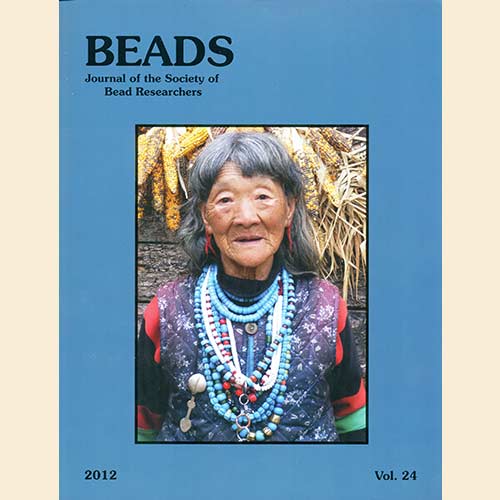Beads 24 (2012)
In Memoriam: Roderick Sprague, 1933-2012, by Karlis Karklins
An archaeologist, educator, and a pioneer in North American trade bead research, Dr. Roderick Sprague passed away in Moscow, Idaho, on 20 August 2012. A staunch supporter of the Society of Bead Researchers, he served as its president from 2004 to 2007, and chaired the Editorial Advisory Committee for a good number of years as well. He also contributed a number of useful articles, news items, and reviews to both the Society’s publications. His moral support and the useful comments and suggestions he made concerning these publications will be sorely missed.
Heirloom Blue-Glass Melon Beads of the Tani Tribes, Northeast India, by Barbie Campbell Cole
The Tani tribes of Arunachal Pradesh in India’s remote northeast wear various heirloom necklaces including those composed of highly distinctive melon-shaped beads of wound turquoise-blue glass. These are unique to central Arunachal and were already of considerable age and very highly prized in the early 19th century. The beads have local names which appear to link them to Tsari, one of Tibet’s most important Buddhist pilgrimage sites. For centuries, the hostile animist Tanis were bought off by the Tibetan government with ornaments and other gifts in return for not robbing the Tsari pilgrims. This article seeks to determine if the Tani melon beads were part of this Tsari “barbarian tribute,” as well as where and when they were made, and why they were traded into this region of Northeast India and not elsewhere.
Chemical Composition of 16th- to 18th-Century Glass Beads Excavated in Paris, by Laure Dussubieux and Bernard Gratuze
Dating from the 16th-18th centuries, 63 glass artifacts (mostly beads) recovered from two sites in Paris, France, were investigated using chemical analysis in an attempt to determine their place of origin. The late-16th-century material from the Jardins du Carrousel consisted of small, monochrome drawn beads with a soda-lime composition. Attributed to the 17th and 18th centuries, the beads recovered at the adjacent site of the Cours Napoléon were more diverse in shape, color, and composition. Although provenance attribution was difficult due to a lack of comparative data, it was possible to identify an increasing variety of glass recipes after the 16th century that revealed a growing interest in glass beads in Europe.
A Classification System for Glass Beads for the Use of Field Archaeologists, by Kenneth E. Kidd and Martha Ann Kidd
As a result of examination of numerous collections of glass beads in northeastern North America and elsewhere, and as a result of a study of the procedures used in their manufacture, the authors propose a classification and nomenclature which they hope will permit exact descriptions and a reference base for all beads found in archaeological excavations. New bead types may be added to the system which is expansible to accommodate all possible variations.
Guide to the Description and Classification of Glass Beads Found in the Americas, by Karlis Karklins
This guide provides information relevant to the description and classification of glass beads recovered from archaeological sites in North and South America and the Caribbean. It is partly based on and intended to be used with “A Classification System for Glass Beads for the Use of Field Archaeologists,” by Kenneth and Martha Kidd. Material presented includes a critical evaluation of several bead classification schemes, an overview of bead manufacturing techniques, a descriptive listing of the various classes and types of beads that have been recorded to date, and an explication of the physical attributes of a bead, as well as interpretative material concerning dating and likely origins.
A Wampum-Inlaid Musket from the 1690 Phips’ Shipwreck, by Charles Bradley and Karlis Karklins
In August of 1690, a fleet of ships under the command of Sir William Phips set sail from Boston to attack Quebec City during the second year of King William’s War. The campaign failed and, as the fleet retreated, a number of vessels were wrecked in the St. Lawrence during a violent storm. The remains of one of these was discovered by a diver in a cove at l’Anse aux Bouleaux, Quebec, in 1994. Believed to be the Elizabeth and Mary, the wreck yielded numerous artifacts, including a wide array of weaponry. Among the long arms was a musket whose stock was decorated on either side with two crosses created by inserting wampum into holes drilled into the wood. Likely the property of a Praying Indian, this unique weapon is described in detail and comparisons made to other contemporary Native American objects decorated in a similar manner.
Book, Video and DVD Reviews in Volume 24
The History of Beads: From 100,000 B.C. to the Present, Revised and Expanded Edition and The Worldwide History of Beads, by Lois Sherr Dubin, reviewed by Margret Carey • Phoenix Rising: Narratives in Nyonya Beadwork from the Straits Settlements, by Hwei-Fe’n Cheah, reviewed by Alice Scherer • Journal: Borneo International Beads Conference 2010, Heidi Munan and Freya Martin, eds., reviewed by Jean Nicholls • Journal: Borneo International Beads Conference 2011, Heidi Munan and Freya Martin, eds., reviewed by Marjorie Bernbaum • African Dolls/Afrikanische Puppen: The Dulger-Collection, by Frank Jolles, reviewed by Marilee Wood • Cherished Curiosity: The Souvenir Beaded Bag in Historic Haudenosaunee (Iroquois) Art, by Gerry Biron, reviewed by Richard Green • Munsell Bead Color Book, by Munsell Color, reviewed by Margret Carey • Beads from Briare, by Floor Kaspers, reviewed by Stefany Tomalin and Deborah Zinn.

